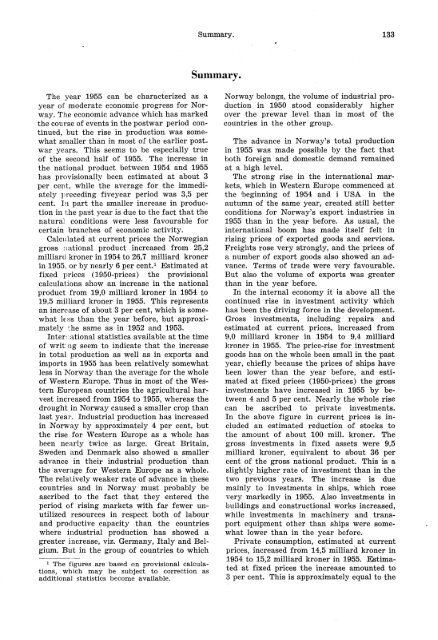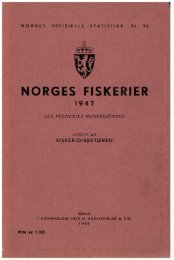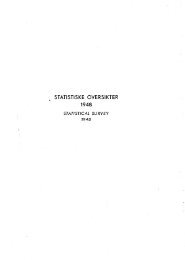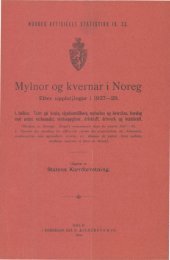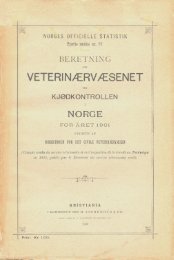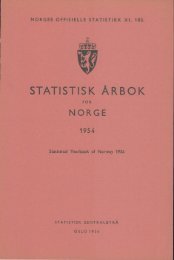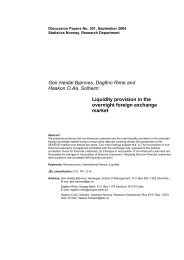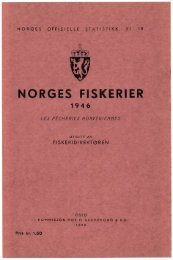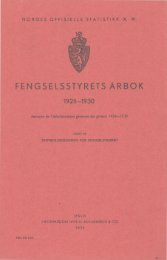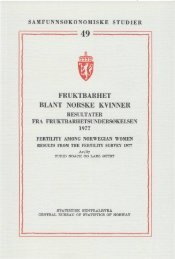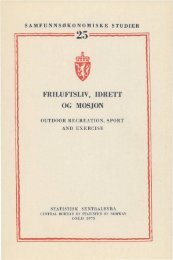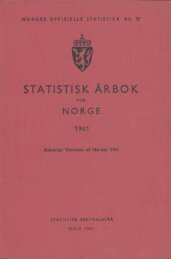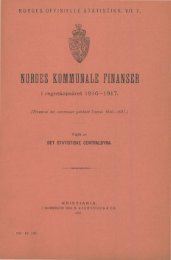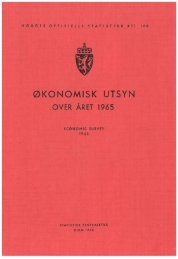XI 217 1955 - Statistisk sentralbyrå
XI 217 1955 - Statistisk sentralbyrå
XI 217 1955 - Statistisk sentralbyrå
Create successful ePaper yourself
Turn your PDF publications into a flip-book with our unique Google optimized e-Paper software.
Summary. 133<br />
Summary.<br />
The year <strong>1955</strong> can be characterized as a<br />
year of moderate economic progress for Norway.<br />
The economic advance which has marked<br />
the course of events in the postwar period continued,<br />
but the rise in production was somewhat<br />
smaller than in most of the earlier postwar<br />
years. This seems to be especially true<br />
of the second half of <strong>1955</strong>. The increase in<br />
the national product between 1954 and <strong>1955</strong><br />
has provisionally been estimated at about 3<br />
per cent, while the average for the immediately<br />
1, receding fiveyear period was 3,5 per<br />
cent. In part the smaller increase in production<br />
in the past year is due to the fact that the<br />
natural conditions were less favourable for<br />
certain branches of economic activity.<br />
Calculated at current prices. the Norwegian<br />
gross rational product increased from 25,2<br />
milliard kroner in 1954 to 26,7 milliard kroner<br />
in <strong>1955</strong>, or by nearly 6 per cent. 1 Estimated at<br />
fixed prices (1950-prices) the provisional<br />
calculations show an increase in the national<br />
product from 19,0 milliard kroner in 1954 to<br />
19,5 milliard kroner in <strong>1955</strong>. This represents<br />
an increase of about 3 per cent, which is somewhat<br />
less than the year before, but approximately<br />
':he same as in 1952 and 1953.<br />
Inter ! .ational statistics available at the time<br />
of writs og seem to indicate that the increase<br />
in total production as well as in exports and<br />
imports in <strong>1955</strong> has been relatively somewhat<br />
less in Norway than the average for the whole<br />
of Western Europe. Thus in most of the Western<br />
European countries the agricultural harvest<br />
increased from 1954 to <strong>1955</strong>, whereas the<br />
drought in Norway caused a smaller crop than<br />
last year. Industrial production has increased<br />
in Norway by approximately 4 per cent, but<br />
the rise for Western Europe as a whole has<br />
been nearly twice as large. Great Britain,<br />
Sweden and Denmark also showed a smaller<br />
advance in their industrial production than<br />
the average for Western Europe as a whole.<br />
The relatively weaker rate of advance in these<br />
countries and in Norway must probably be<br />
ascribed to the fact that they entered the<br />
period of rising markets with far fewer unutilized<br />
resources in respect both of labour<br />
and productive capacity than the countries<br />
where industrial production has showed a<br />
greater increase, viz. Germany, Italy and Belgium.<br />
But in the group of countries to which<br />
The figures are based on provisional calculations,<br />
which may be subject to correction as<br />
additional statistics become available.<br />
Norway belongs, the volume of industrial production<br />
in 1950 stood considerably higher<br />
over the prewar level than in most of the<br />
countries in the other group.<br />
The advance in Norway's total production<br />
in <strong>1955</strong> was made possible by the fact that<br />
both foreign and domestic demand remained<br />
at a high level.<br />
The strong rise in the international markets,<br />
which in Western Europe commenced at<br />
the 'beginning of 1954 and i USA in the<br />
autumn of the same year, created still better<br />
conditions for Norway's export industries in<br />
<strong>1955</strong> than in the year before. As usual, the<br />
international boom has made itself felt in<br />
rising prices of exported goods and services.<br />
Freights rose very strongly, and the prices of<br />
a number of export goods also showed an advance.<br />
Terms of trade were very favourable.<br />
But also the volume of exports was greater<br />
than in the year before.<br />
In the internal economy it is above all the<br />
continued rise in investment activity which<br />
has been the driving force in the development.<br />
Gross investments, including repairs and<br />
estimated at current prices, increased from<br />
9,0 milliard kroner in 1954 to 9,4 milliard<br />
kroner in <strong>1955</strong>. The price-rise for investment<br />
goods has on the whole been small in the past<br />
year, chiefly because the prices of ships have<br />
been lower than the year before, and estimated<br />
at fixed prices (1950-prices) the gross<br />
investments have increased in <strong>1955</strong> by between<br />
4 and 5 per cent. Nearly the whole rise<br />
can be ascribed to private investments.<br />
In the above figure in current prices is included<br />
an estimated reduction of stocks to<br />
the amount of about 100 mill. kroner. The<br />
gross investments in fixed assets were 9,5<br />
milliard kroner, equivalent to about 36 per<br />
cent of the gross national product. This is a<br />
slightly higher rate of investment than in the<br />
two previous years. The increase is due<br />
mainly to investments in ships, which rose<br />
very markedly in <strong>1955</strong>. Also investments in<br />
buildings and constructional works increased,<br />
while investments in machinery and transport<br />
equipment other than ships were somewhat<br />
lower than in the year before.<br />
Private consumption, estimated at current<br />
prices, increased from 14,5 milliard kroner in<br />
1.954 to 15,2 milliard kroner in <strong>1955</strong>. Estimated<br />
at fixed prices the increase amounted to<br />
3 per cent. This is approximately equal to the


